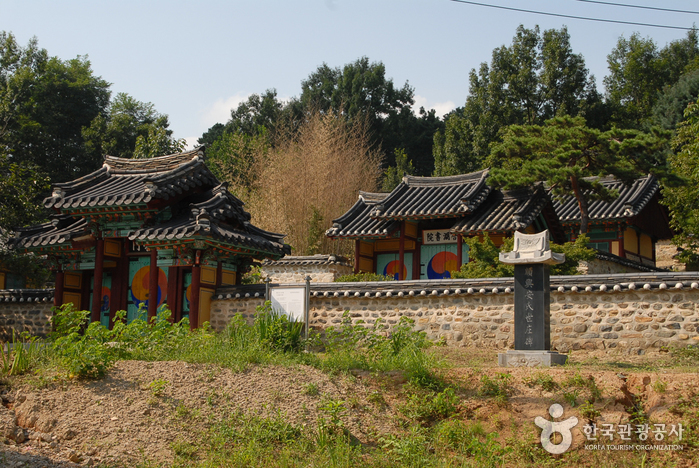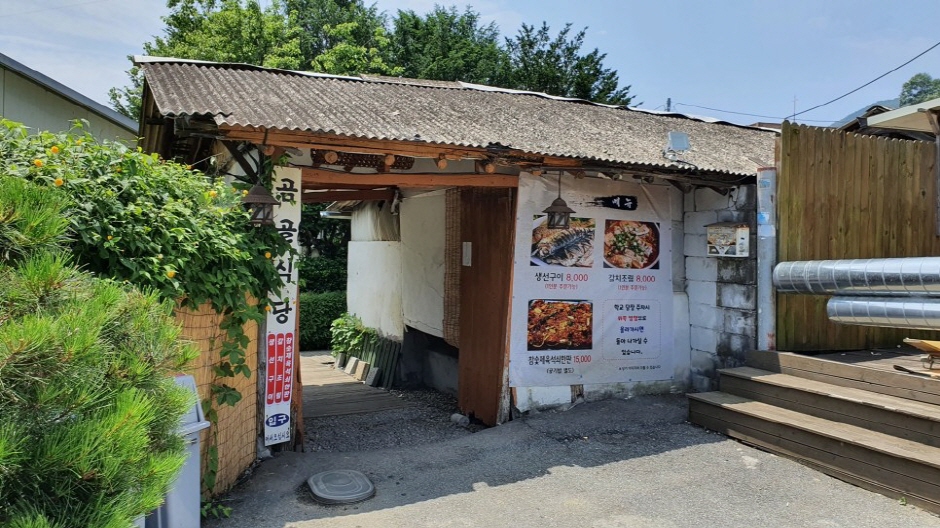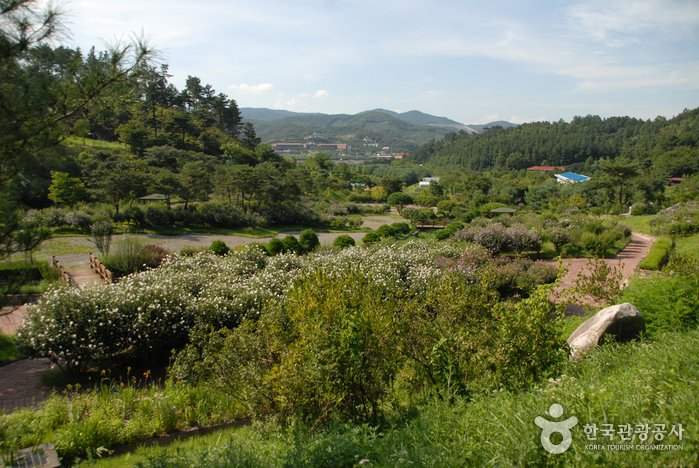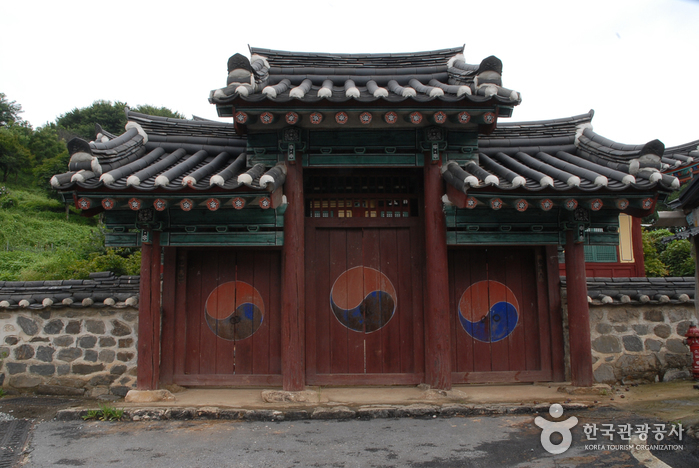BOK Art Center (비오케이아트센터)
12.0 Km 0 2023-01-25
12, Gukchaegyeonguwon 3-ro, Sejong-si
+82-1877-4955
BOK Art Center is located in Bangok-dong, Sejong-si. It was opened in 2019 with the management philosophy of CEO I Gyu-sun, 'Let's create a happier living space.' The center is equipped with a performance hall where various performances are held, a gallery where various exhibitions are held, a hobby factory specialized for kidults, a Ccume Baking Class where you can enjoy baking, a bookstore, and a cafe.
Gongju Hanok Village [Korea Quality] / 공주한옥마을 [한국관광 품질인증]
12.0 Km 11825 2020-09-09
12, Gwangwangdanji-gil, Gongju-si, Chungcheongnam-do
+82-10-3451-5769
Gongju Traditional Korean Village is located between the Tomb of King Muryeong and the Gongju National Museum in Gongju, which is often referred to as ‘a roofless museum’ due to the preponderance of historic sites. Opened as a hanok stay on a 30,000m2 site in 2010, the Village, which is entirely composed of tiled-roof hanok houses and thatched-roof houses, offers attractive hanok accommodation that combines traditional and modern styles, and has rooms equipped with a Korean floor heating system (gudeul), as well as a pavilion. It also runs diverse experience programs relating to the history of the Baekje Kingdom. It comprises six group accommodation buildings and ten individual accommodation buildings. The group accommodation buildings, which are recommended for group workshops and school trips, have individual locker rooms and shower rooms, while the individual accommodation building, which is recommended for families and small groups, has four economy-type rooms which share a communal space, and five general-type rooms and two high-class rooms that are equipped with a Hinoki cypress bathtub. The rooms can be opened and locked using a card-key system for guests’ convenience and security. The Village also runs a number of popular experience programs including Storytelling of Baekje Tea, a tea ceremony program coupled with a story about Baekje royal tea, and a Gongju chestnut cookie making experience that offers guests an opportunity to make tea confectionery by mixing chestnut powder and mixed-grain powder with honey. It also runs various programs relating to the history and culture of Baekje, including programs in which participants can wear a Baekje royal costume, learn how to bind books in the Baekje style, and make Baekje relics.
Baekje Experience Center (백제오감체험관)
12.1 Km 0 2024-01-08
30 Gomanaru-gil, Gongju-si, Chungcheongnam-do
The Baekje Experience Center offers a rich array of activities that allow visitors to engage with the history they have observed at the nearby ancient tombs in Songsan-ri and the Gongju National Museum in a tactile manner. This center features eight themed halls across the first basement, and the first and second above-ground floors, offering interactive and gaming programs designed to stimulate all five senses. Activities such as rubbing pattern experience and luminous stamps allow visitors to learn about and appreciate the culture and history of Woongjin Baekje in an intuitive way. One of the center’s highlights is the Window of Sympathy in the first-floor lobby. This impressive two-story panel changes its color in response to sound and touch, promising to attract significant attention from tech-savvy visitors. It showcases content that guests have captured within the center and shared on social media, complete with hashtags. Additionally, the Window of Creation on the same floor offers a unique creative outlet. Here, visitors can color Baekje-era relics with crayons. These artworks are then transformed into graphic mapping images on the wall via a scanner, allowing for a personalized and immersive historical experience.
Haposeowon Confucian Academy (합호서원)
12.6 Km 4397 2022-08-18
262-6, Wonhapgang 1-gil, Yeondong-myeon, Sejong
+82-44-330-5832
Registered as Cultural Heritage Material, Haposeowon Confucian Academy is where the spiritual tablet of An Hyang, a respected scholar during the Goryeo period, is enshrined. The academy was founded in 1716 by the scholar's descendants, who held regular memorial services until a royal order to close down most seowon institutions was made in the late Joseon dynasty. In 1949, Haposeowon Confucian Academy was rebuilt as an affiliated institution with the consent of 218 local Confucian schools nationwide.
Restaurant Gomgol (곰골식당)
12.6 Km 0 2024-01-09
1-2 Bonghwangsan 1-gil, Gongju-si, Chungcheongnam-do
This renowned restaurant in Gongju is always bustling. Upon passing through its old, time-honored main gate, one is greeted by a tastefully minimalist garden leading to the eatery itself. The restaurant boasts a carefully selected main menu, offering just three specialty dishes: charcoal-grilled spicy pork, grilled fish, and braised cutlassfish. Each meal is accompanied by an abundant array of ssam (wrap) vegetables and delicious side dishes, available for unlimited refills at the self-service bar. The charcoal-grilled spicy pork is expertly cooked for immediate enjoyment, without the need for diners to grill it themselves. The smoky aroma of the charcoal complements the subtle seasonings perfectly. The grilled fish offers a delightful contrast with its crispy skin and succulent flesh. An additional perk is the option to order single servings of all menu items.
Bonghwangjae Hanok Guesthouse [Korea Quality] / 봉황재 한옥 게스트하우스 [한국관광 품질인증/Korea Quality]
12.7 Km 20 2021-03-29
8, Keunsaem 3-gil, Gongju-si, Chungcheongnam-do
+82-41-960-5525
Bonghwangjae Hanok Guesthouse exemplifies the quintessential hanok (traditional Korean house) experience. It is housed in a remodeled modern hanok, built in the 1960s. There are 4 rooms in total. The biggest room is a two-story room with an attic space. It can accommodate up to 4 guests, making it the favorite of family travelers. The room at the very end is the smallest room, but has an open narrow floor space that is ideal for some quiet time facing the courtyard. It can accommodate up to 3 guests. The other two rooms are small and comfortable, fit for 2 to 3 guests. Each room is equipped with a bathroom. The wooden-floored hall, kitchen, courtyard, and backyard are common areas used by all guests. Guests can also sign up for “Gongju Old City Tour on Foot,” which is led by the owner of the house. Complimentary breakfast includes toast, jam, eggs, cereal, and milk. A package program offers snapshot photography from a professional photographer for those staying in this guesthouse. The guesthouse lies only 5 min away from the Chungcheonggamyeong Provincial Office Site and Daetongsa Temple Site by foot, while Sanseong Market, Gongsanseong Fortress, and former Missionary House are reachable in 10 min.
Geumgang Recreational Forest (Arboretum, Forest Museum) (금강자연휴양림(금강수목원,산림박물관))
13.3 Km 76633 2021-04-29
110, Sallimbangmulgwan-gil, Sejong-si
+82-41-635-7400
Along the river from Gongju toward Daejeon there is Geumgang River to the right. Following this river, there is a red arch-shaped bridge on the right called Bultigyo Bridge. Geumgang Recreational Forest, a large and well-organized forest, is located on the other side of this bridge. In the past, this remote village can only be reached by boat. In 1994, the Chungnam Forest Environment Research Institute moved to this area and designated the well-preserved dense forest as Geumgang Recreational Forest, and the Forest Museum opened in October 1997. Geumgang Recreational Forest is different from other recreational forests. Rather than a dense forest with a trail, this forest has a variety of attractions such as the Forest Museum, an arboretum, greenhouse, pond, and wildlife park scattered on well-maintained roads, giving the impression of a city park.
Beartree Park (베어트리파크)
13.5 Km 47212 2022-12-26
217, Sinsong-ro, Sejong-si
+82-44-866-7766
Beartree Park is a beautiful natural space in Sejong founded by entrepreneur Lee Jae-yeon. The park first started out as a private garden cared for by Lee personally. The garden was turned into a park and opened to the public in 2009, boasting a beautiful collection of flora and fauna. Indoor and outdoor botanical gardens, junipers, wild flowers, irises, and bonsais are tended with the utmost of care. In addition to the magnificent gardens, visitors can also observe family of deer, bears, birds, and more.
E-An Land (이안숲속)
14.3 Km 18071 2020-04-24
25, Sumogwon-gil, Gongju-si, Chungcheongnam-do
+82-41-855-2008
E-An Land Forest was established in 1999 when 1,836 arbor species and 1,418 herb species were planted on a land area of 1,118 hectares. The forest features a tropical garden and various other exhibition gardens, as well as thematic spaces like the Haneul Maru. The forest was finally completed in 2006. Inside the arboretum, there are various things to see such as the herb village, parakeet exhibitions, a pine tree garden, and man-made cave. There is also a mini golf course and an outdoor swimming pool. Visitors can also use the onsite pensions and the auto camping site for accommodation, making the E-An Land Forest a great place for family and group visitors.
Jeonuihyanggyo Confucian School (전의향교)
14.4 Km 4812 2022-12-26
5-18, Bukchon 1-gil, Sejong-si
+82-44-211-4022
Jeonuihyanggyo Confucian School is thought to have been built in 1413 during the 13th year of King Taejong’s reign. The school features a simple spatial arrangement with only Myeongnyundang and Daeseongjeon Study Halls, each with three gates in the front. Outside the western wall of Myeongnyundang Hall is Sujiksa Temple.
Several books - Jaeimnok, Seonan, several texts on rituals, and Eojeyuneum (1782-1783), which was published in 1782 (6th year of King Jeongjo’s reign) and 1783, have been found at Jeonui Hyanggyo.

![Gongju Hanok Village [Korea Quality] / 공주한옥마을 [한국관광 품질인증]](http://tong.visitkorea.or.kr/cms/resource/63/2580363_image2_1.jpg)


![Bonghwangjae Hanok Guesthouse [Korea Quality] / 봉황재 한옥 게스트하우스 [한국관광 품질인증/Korea Quality]](http://tong.visitkorea.or.kr/cms/resource/81/2707581_image2_1.jpeg)


 English
English
 한국어
한국어 日本語
日本語 中文(简体)
中文(简体) Deutsch
Deutsch Français
Français Español
Español Русский
Русский